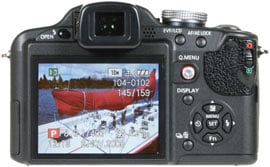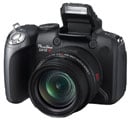Panasonic Lumix DMC-FZ28
-
-
Written by Gordon Laing
Panasonic Lumix DMC-FZ28 verdict
The Panasonic Lumix DMC-FZ28 represents a fairly minor upgrade over its predecessor, but given that was our favourite super-zoom of 2007, the new model has a great deal going for it. So with the FZ28 you get a compact, lightweight super-zoom camera with 10 Megapixel resolution, a huge 18x optically-stabilised range, HD video recording in the 720p format, support for RAW files, a mid-sized, but good-looking 2.7in screen, manual controls and one of the best fully automatic modes on the market. It’s a lot of camera for the money.
The super-zoom range of course remains the highlight here, taking you from decent wide angle coverage to super-telephoto. The wide angle is ideal for capturing big scenes, whether expansive landscapes, large buildings, cramped interiors or big group shots, but if you spot something interesting in the distance you can effortlessly zoom-in on it in a couple of seconds. It sounds like an advert, but we really did find ourselves spotting wildlife opportunities while shooting wide landscapes, and being able to capture both moments apart. Once you take the excellent macro and effective stabilisation into account, it really does give you enormous compositional flexibility.
Super-zoom ranges often involve optical compromises, but any nasty artefacts like coloured fringing are digitally corrected by the FZ28 in-camera, leaving your JPEGs impressively clean – be sure to compare the difference this makes in our comparisons against the Canon SX10 IS on our results pages.
|
The ability to record RAW images is also a key highlight of the FZ28 and gives its files greater flexibility than those from the SX10 IS. The inclusion of HD video is the icing on the cake. The video may have a visible graininess that won’t come near to the quality of a dedicated camcorder, but it’s still a step-up from standard definition modes on other cameras, again including the SX10 IS.
The FZ28’s body is also surprisingly small and light, which many will consider a key advantage, especially if you’re hiking or travelling light – unlike the relatively hefty SX10 IS, you’ll hardly notice you’re carrying it.
But almost all of these benefits were available on its predecessor the FZ18. HD recording aside, the FZ18 also featured an 18x zoom range in a small and light body with manual control, in-camera correction of fringing and RAW recording.
The 2 Megapixel boost in resolution certainly records more detail than its predecessor in technical tests, but there’s not a significant difference in terms of real life detail. Noise levels are roughly the same and as before, you’ll want to stick to 100 ISO for the best results. Even then, there’s a sprinkling of fine textures if you’re looking closely, and when increased to 200 ISO and beyond, there’s a steady decrease in fine detail. Like the SX10 IS, this is in line with most compacts these days though and you can see examples in our High ISO Noise Results page.
The slightly larger screen looks better, and is more visible in direct sunlight, although sadly the electronic viewfinder has shrunk in apparent size. The latest incarnation of Intelligent Auto is nice to have, as are the improved face detection, AF tracking, and High Speed Burst mode, but none are exactly revolutionary. The biggest single improvement for us is the inclusion of an HD movie mode.
 |
The FZ28 is also not without its faults. Like all cameras with tiny sensors and high resolutions, diffraction is an issue at smaller apertures. This is well-known, but most compacts employ Program lines which try and avoid these troublesome large f-numbers where possible. Like its predecessor though, the FZ28 has a habit of sitting at a maximum shutter speed of 1/500, and closing its aperture to between f5.6 and f8 under bright conditions.
Now most compacts may be unable to use their fastest shutter speeds at anything other than their minimum aperture, but the FZ28 can support 1/1000 at its full range of apertures, so there’s no excuse. Of course it’s possible to select smaller f-numbers by using Program Shift or Aperture Priority, but we were concerned how many times the FZ28 used f8 in Program mode when it wasn’t necessary – see our Gallery page for examples. So if you’re using the FZ28 in Program or Auto in bright conditions, watch out.
We also don’t want to penalise any company which is considerate enough to supply a lens hood, but the FZ28’s is impractical for two reasons: first it’s too large to reverse over the barrel for convenient transportation, and secondly you need to manually rotate it to the correct position before tightening a thumbscrew, which introduces the possibility of alignment error. We should also mention the lens cap impedes the lens as it extends during power-up which can be annoying.
To be fair though, these are all fairly minor downsides. The bottom line is the FZ28 for its minor upgrades is still an improvement overall on its predecessor, and that’s a good thing. It’s biggest problem is extremely tough competition from Canon’s latest PowerShot SX10 IS, which brings us neatly to our comparison section.
Compared to Canon PowerShot SX10 IS
 |
The FZ28’s biggest rival is the Canon PowerShot SX10 IS. Both cameras share 10 Megapixel resolution, optically-stabilised super-zooms with wide angle coverage, full manual control and DSLR-styled bodies, but beyond these, there’s pros and cons to each model.
Most obviously the SX10 IS has a slightly longer 20x zoom range, a slightly smaller but fully-articulated screen which allows comfortable composition at any angle, a flash hotshoe for mounting external Speedlites, a larger electronic viewfinder, and movies with stereo sound and more efficient compression. Both cameras may have full manual control, but spinning the large thumb wheel of the Canon is ergonomically superior to prodding the tiny joystick on the Panasonic. Finally, the Canon may be larger and heavier, but many will prefer its heft, along with the convenience of picking up spare batteries almost anywhere. It’s a small point, but the SX10 IS’s lens cap also won’t prevent the lens from extending, and its lens hood is more portable.
The FZ28’s optical range may be slightly shorter, but as seen on our Features page, it doesn’t make a significant difference in practice – and more importantly, the FZ28 avoids the coloured fringing seen towards the corners in many of the Canon’s images. It’s also worth noting the maximum aperture of the FZ28 when zoomed-into 486mm is a brighter f4.4, compared to f5.7 of the SX10 IS from 460-560mm. Unlike the SX10 IS, the FZ28 also features RAW recording facilities, automatic scene recognition, a longer maximum exposure of 60 seconds, and some usable burst options, albeit either with a limited buffer or at a reduced resolution. The FZ28 additionally offers HD movies in the 720p format along with optional Component output to HDTVs, and some will prefer its rechargeable Lithium Ion battery pack to the AAs of the SX10 IS.
The FZ28 is also a smaller and considerably lighter camera, weighing 417g with its battery compared to the 680g of the SX10 IS when fitted with four typical AA batteries. It additionally sports a slightly larger – albeit fixed – 2.7in screen which looks more vibrant in use. Finally, depending on the shop, the price of the FZ28 is 10 to 25% cheaper than the Canon.
It really is a case of swings and roundabouts though, with neither model taking an obvious lead. Both are superb superzooms, so when choosing between them, it’s crucial to be honest with yourself about which features are most important to you. Check out our Canon PowerShot SX10 IS review for more details.
Compared to Canon PowerShot SX1 IS
 |
Canon’s PowerShot SX1 IS may be comfortably more expensive than the FZ28, or indeed the SX10 IS, but its unique enhancements over the latter are causing quite a buzz in the market. The SX1 IS was launched alongside the SX10 IS and is identical other than a slightly larger 2.8in widescreen monitor and a CMOS sensor in place of the CCD in the SX10 IS. This makes it the first non-DSLR from Canon to sport a CMOS sensor and equips the SX1 IS with three major advantages over the SX10 IS.
First is the ability to shoot high definition video in the full 1080P format. Second is the ability to shoot full resolution images at a much quicker continuous rate of 4fps. Third is an HDMI port for connecting to HDTVs. These upgrades are the icing on the cake of a camera that still sports 10 Megapixel resolution, a fully articulated screen, a flash hotshoe and of course that enormous 20x optically stabilised zoom lens. With 1080P, 4fps and HDMI, the SX1 IS also manages to trump the video, continuous shooting and HD output of the FZ28. A recent firmware update also equips the SX1 IS with RAW recording facilities.
All this makes the SX1 IS one of the most desirable super-zooms on the market, but there’s one major downside: it’s priced comfortably higher than the FZ28, and indeed Canon’s own PowerShot SX10 IS. So the question you have to ask yourself is whether it’s worth paying the extra for HD movie recording and quick continuous shooting. Find out how it measures-up in our Canon PowerShot SX1 IS review.
Also consider
Two other super-zooms worth considering are the 20x Olympus SP-570UZ and the 15x Sony Cyber-shot DSC-H50 – click the links for their current US pricing. Both are strongly based around previous models we’ve reviewed at Cameralabs, but with inevitable boosts in resolution, and in the case of the Olympus, a longer 20x optical range.
Panasonic Lumix DMC-FZ28 final verdict
As we said at the top, the Lumix FZ28 may only represent a minor upgrade over its predecessor, but since that was already one of the best super-zooms around, it places the FZ28 in an even stronger position. Beyond minor irritations with the lens hood, cap and Program line selecting smaller apertures than it needs to, there’s really very little to fault it on.
Buy the FZ28 and you’ll get a compact, lightweight super-zoom camera with 10 Megapixel resolution, a huge 18x optically-stabilised range, HD video recording in the 720p format, support for RAW files, a mid-sized, but good-looking 2.7in screen, manual controls and one of the best fully automatic modes on the market. Once again it’s a compelling specification and represents great value even if the EVF has shrunk.
But then for only a small amount extra you could alternatively buy the Canon PowerShot SX10 IS with its 20x range, fully articulated flip-out screen, flash hotshoe and stereo sound, albeit without the RAW files, HD video and fringing correction of the Panasonic.
As mentioned above, there’s no clear winner between them, with the choice boiling down to which feature set best-suits your requirements, along with which model looks and feels best in your hands. Then there’s also the promise of Canon’s higher-end SX1 IS to consider.
Should you ultimately decide on the Panasonic FZ28 though, you won’t be disappointed. Like its predecessor it delivers a compelling array of features for the money and easily comes Highly Recommended. But unlike the FZ18, it’s now up against an equally compelling rival in the form of Canon’s SX10 IS – be sure to compare them very closely.
|
Bad points | Scores (relative to 2008 super-zooms) |
 | ||
Build quality: Image quality: Handling: Specification: Value:
Overall: |
17 / 20 17 / 20 17 / 20 17 / 20 18 / 20
86% | |||
| ||||




